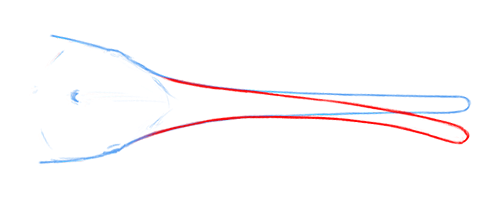Last week’s weird-snouted Furcacetus wasn’t the only recently-discovered ancient platanistoid dolphin that deserves some attention.
Ensidelphis riveroi was described in the same paper, and also lived in the coastal waters around Peru during the early Miocene, about 19 million years ago. It was a little less closely related to its modern river-dwelling cousins than Furcacetus, and was slightly larger, estimated to have measured about 3m long (9’10”).
But what made it weird was its incredibly long snout, lined with around 256 tiny sharp teeth, which also curved markedly to the right side along its 55cm (1’10”) length.

With only one known skull of Ensidelphis it’s impossible to tell if this was a natural condition for the species or if it was some sort of anomalous individual. It doesn’t seem to be a deformation of the fossil, at least.
Similar unusual right-side bending has been seen in the skulls of a few individuals of modern South Asian river dolphins, franciscanas, and Amazon river dolphins, possibly caused by injuries at a young age being exaggerated as the animals grew. However, many other platanistoid dolphins (especially squalodelphinids) are known to have naturally had similar bends in their snouts – but always to the opposite side, curving to the left instead of the right.
But naturally bent or not, what might Ensidelphis have been doing with that incredibly lengthy snoot?
Its long slender jaws would have had a fairly weak bite, so it probably wasn’t able to catch large prey, and it had a very flexible neck. Possibly it swam along near the seafloor using its snout to probe and sweep around in the sediment for buried small prey.
Modern South Asian river dolphins swim along on their sides while doing this – almost always on their right sides, interestingly enough – and if Ensidelphis did the same sort of thing then a snout bent in that direction might have been an advantage.

